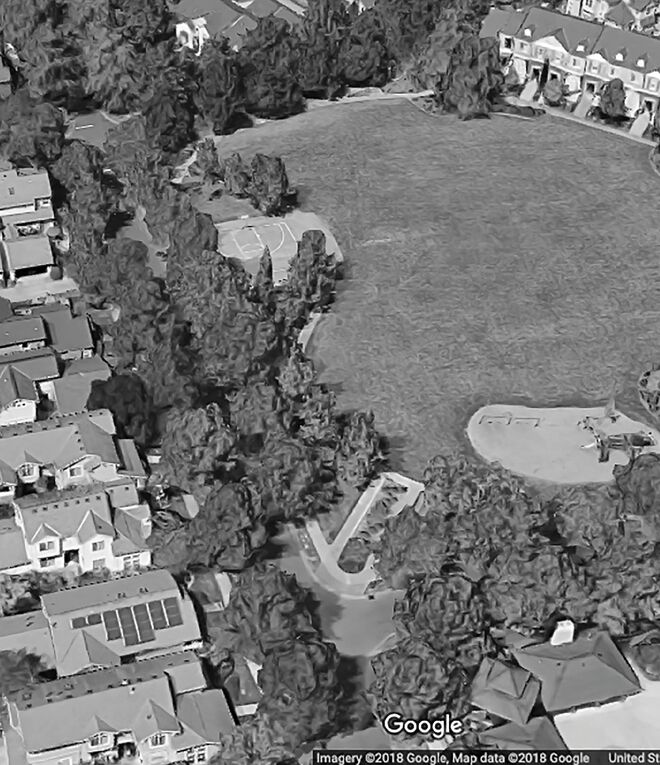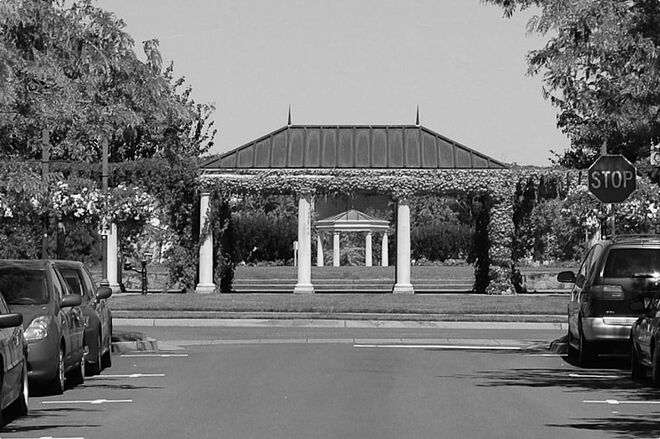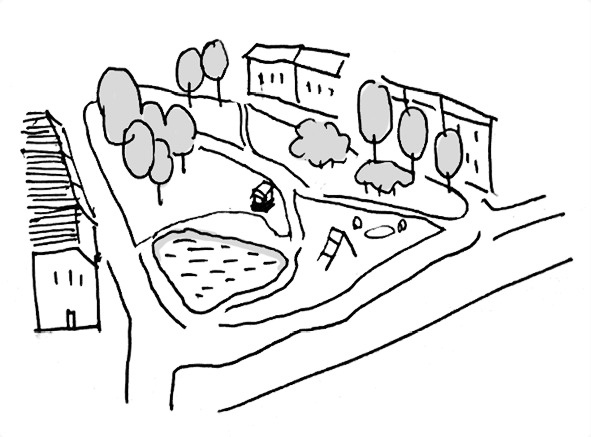4.4. Neighborhood Park
Aus Pattern Language Wiki
Within the Pedestrian Sanctuary, provide amenities for recreation and gathering.
Problem-statement: At the scale of a neighborhood, there is a need for quieter recreational spaces with ample vegetation, and more protected from faster-moving vehicles.
Discussion:: Neighborhood parks are not the same as regional parks, which may be quite large. Generally, neighborhood parks can range from one hectare (2.5 acres) to as small as 20 square meters (200 square feet) or the size of a “pocket park”. The important factor is that every residence is within about 250 meters, or about 750 feet, of one of these parks. A secondary factor is that these spaces are focal points for the surrounding neighborhood, allowing quieter family-scale gatherings and informal sports events.
Overwhelming scientific evidence links human health to intimate exposure to natural green vegetation, as discussed in the pattern Biophilic Urbanism. At the same time, people will not use a park frequently unless it is close to their home, and easily accessible by foot. This implies a need for local neighborhood parks distributed regularly throughout the city — close enough for everyone to access one or more by walking. That suggests a distribution of approximately 400 meters (1300 feet), so that each home is within 200 meters (650 feet) of one or more parks.
A key requirement for neighborhood parks is that they are visible from nearby residences, and there is an opportunity for residents to provide stewardship for their security and care. There is also a need to have active uses along their edges, so that these edges do not become dead zones, severing and isolating the parks from the surrounding neighborhood.¹
Neighborhood parks can also provide pavilions and other shelters to allow for small-scale events such as weddings, acoustic music performances, and other activities that are compatible with surrounding residences.
Therefore:
Within the sanctuaries, create neighborhood parks that serve as quiet oases for residents, with ample greenery and natural characteristics such as ponds and waterfalls. Assure that one of these parks is within about 200 meters (650 feet) of every residence. Provide for recreational activities including play structures for children. Provide sheltered spaces for activities including acoustic music and small neighborhood gatherings.
Create room-like spaces, especially at the edges, forming a Place Network…
¹ One of the seminal accounts of neighborhood park structure and its requirements was provided by Jane Jacobs in her landmark The Death and Life of Great American Cities, and especially , Chapter 5, “The Uses of Neighborhood Parks.” See Jacobs, J. (1961) The Death and Life of Great American Cities. New York: Random House.
Mehaffy, M. et al. (2020). NEIGHBORHOOD PARK (pattern). In A New Pattern Language for Growing Regions. The Dalles: Sustasis Press. Available at https://pattern-language.wiki/.../Neighborhood_Park
SECTION I:
PATTERNS OF SCALE
1. REGIONAL PATTERNS
Define the large-scale spatial organization…
1.4. 400M THROUGH STREET NETWORK
2. URBAN PATTERNS
Establish essential urban characteristics…
3. STREET PATTERNS
Identify and allocate street types…
4. NEIGHBORHOOD PATTERNS
Define neighborhood-scale elements…
5. SPECIAL USE PATTERNS
Integrate unique urban elements with care…
6. PUBLIC SPACE PATTERNS
Establish the character of the crucial public realm…
7. BLOCK AND PLOT PATTERNS
Lay out the detailed structure of property lines…
8. STREETSCAPE PATTERNS
Configure the street as a welcoming place…
9. BUILDING PATTERNS
Lay out appropriate urban buildings…
10. BUILDING EDGE PATTERNS
Create interior and exterior connectivity…
10.1. INDOOR-OUTDOOR AMBIGUITY
SECTION II:
PATTERNS OF MULTIPLE SCALE
11. GEOMETRIC PATTERNS
Build in coherent geometries at all scales…
11.2. SMALL GROUPS OF ELEMENTS
12. AFFORDANCE PATTERNS
Build in user capacity to shape the environment…
13. RETROFIT PATTERNS
Revitalize and improve existing urban assets …
14. INFORMAL GROWTH PATTERNS
Accommodate “bottom-up” urban growth…
15. CONSTRUCTION PATTERNS
Use the building process to enrich the result…
SECTION III:
PATTERNS OF PROCESS
16. IMPLEMENTATION TOOL PATTERNS
Use tools to achieve successful results…
16.2. ENTITLEMENT STREAMLINING
16.3. NEIGHBORHOOD PLANNING CENTER
17. PROJECT ECONOMICS PATTERNS
Create flows of money that support urban quality…
17.4. ECONOMIES OF PLACE AND DIFFERENTIATION
18. PLACE GOVERNANCE PATTERNS
Processes for making and managing places…
18.3. PUBLIC-PRIVATE PLACE MANAGEMENT
19. AFFORDABILITY PATTERNS
Build in affordability for all incomes…
19.1. INTEGRATED AFFORDABILITY
20. NEW TECHNOLOGY PATTERNS
Integrate new systems without damaging old ones…
20.2. RESPONSIVE TRANSPORTATION NETWORK COMPANY


